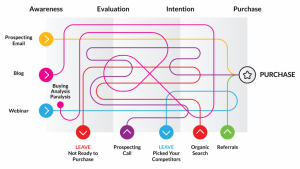Marketers and salespeople (still) struggle with unhealthy tension in 2020 and unless it’s resolved, it impacts the performance that these two departments are responsible for: growth and revenue.
Sales and Marketing misalignment is costing businesses money. A lot of money. Research concludes that B2B businesses who have banished the friction are 38% better at closing, have a 62% higher contribution to new business revenues and 36% less churn. Operating and reacting faster and reducing the sales cycle also receive a healthy boost.
Compelling reasons. But, if this time-honoured feud stands firm within your business, what can you do (today) to align your teams and bring the mojo back to your most important department?
Who is Responsible for What?
Marketing has traditionally owned the top of the funnel, handing leads to sales. Fast-forward to 2020. The lines are officially blurred – which is actually OK and can and should be used to your advantage. Marketing and sales now interact successfully at various points of the buyers’ journey – which has totally transformed. Salespeople have confirmed that closing is harder, with many buyers wanting little to no influence from a vendor, instead favouring independent research.
This natural response to the expanse of information at our fingertips means that salespeople have to work smarter in order to meet demanding revenue targets and engage with buyers. B2B companies, particularly those (such as tech companies) with a long sales cycle, now flourish salespeople with tools in order to open up more dialogue and populate the sales funnel. But Sales cannot single-handedly create the necessary touchpoints that buyers crave throughout the sales cycle – particularly as the cycle can now be up to 2-years long.
Marketing must nurture, inform and communicate with buyers as they move through the funnel with relevant, tailored content. With on average 15 decision-makers involved in the B2B tech buying process, white papers, product demos and layered content must be targeted at the stakeholders associated with the decision.
Align from the Top
The two functions are invariably different which is often a contributing factor towards the negativity. Marketing is targeted with lead generation (for example) and Sales with progressing and closing the lead. Cue the finger-pointing. You may yourself be operating two different functions that are not aligned and do not work as well as they should. If this feels familiar, you will need to look from the top down. Are CROs and CMOs united and creating a culture that facilitates teamwork? Here are ten pointers to consider:
- Create a shared vision
- Jointly agree meaningful metrics of success
- Instil a culture of accountability, clarity and respect
- Consider the best tools to boost collaboration
- Encourage regular touch points and team meetings (daily, weekly, scrum)
- Clearly define the merged tasks and responsibilities
- Invest in work management tools
- Align the tools, processes and people
- Obtain awareness of each other’s roles and how to better support each other and why
- Give both teams airtime and review feedback and success together
Joint success will give everyone encouragement and confidence in the processes and each other.
Agree on the Metrics
The historical baton-passing needs to be drawn to a close. Sit everyone together and collectively agree on the metrics that matter. Create fixed processes for prospecting, nurturing, conversion and after-sales. Smarketing may be a slightly cheesy term, but its connotations hit all the right notes. You may not be (understandably) about to rename your Sales and Marketing teams as ‘Smarketing’, but creating this way of thinking should be encouraged. One team, one goal, work together.
Create A Single Customer Journey
B2B buyers demand a seamless approach. To be effective, you need to map out the buyers’ journey and provide a unified, single experience. There is no better place to begin than by getting everyone together and mapping out the entire customer journey. From the top of the funnel right through to brand loyalty – aim for a unified experience and feel. Technology, such as your CRM, will support you in providing the insight and data necessary for a superior, singular customer journey for every buyer and persona. Email marketing, analytics and marketing automation should follow suit.
Deliver What You Promise
Sales and Marketing should continually influence buyers and customers. Attracting new customers is far more expensive than retaining those that you have. Existing customers are not a ‘done deal’. Sales and Marketing must always be talking to and nurturing customers and prospects in order to influence them to buy new products, upgrade, add more licenses, etc. Only together, can Sales and Marketing increase the lifetime value of your customers, deliver what they promise and provide the best experience.
Imagine what can be done with everyone truly working together…crazy talk, we know…





